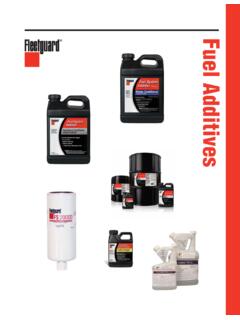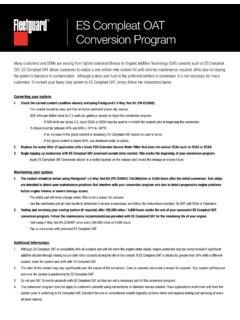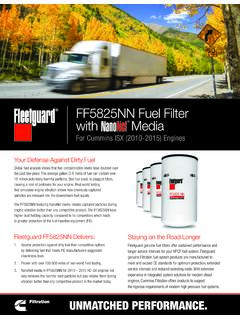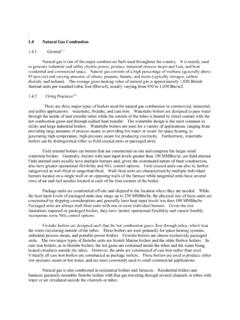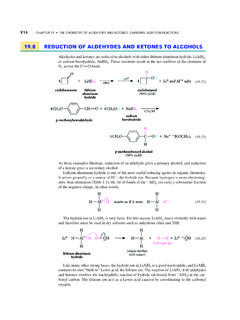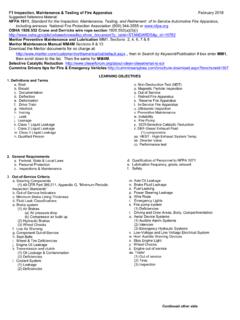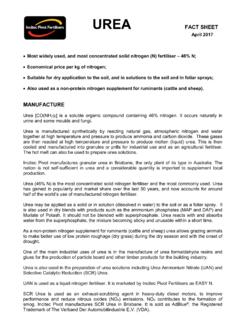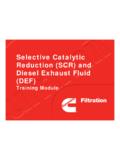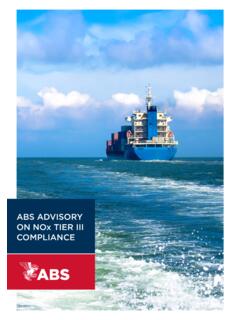Transcription of Diesel Exhaust Fluid (DEF) Q & A - Cummins Filtration
1 Diesel Exhaust Fluid (DEF) Q & A BULLETIN SCR: The Leading Technology to Meet 2010 Emission Regulations Q. What is selective catalytic reduction (SCR)? A. SCR is a technology that uses a urea based Diesel Exhaust Fluid (DEF) and a catalytic converter to significantly reduce oxides of nitrogen (NOx) emissions. SCR is the leading technology being used to meet 2010 emission regulations. Q. How does an SCR system work? A. The purpose of the SCR system is to reduce levels of NOx (oxides of nitrogen emitted from engines) that are harmful to our health and the environment. SCR is the aftertreatment technology that treats Exhaust gas downstream of the engine. Small quantities of Diesel Exhaust Fluid (DEF) are injected into the Exhaust upstream of a catalyst, where it vaporizes and decomposes to form ammonia and carbon dioxide. The ammonia (NH3) is the desired product which in conjunction to the SCR catalyst, converts the NOx to harmless nitrogen (N2) and water (H2O).
2 Q. What are the advantages for the fleet in using SCR technology? A. Cummins 2010 engines will deliver what customers need in these challenging economic times. Cummins 2010 heavy duty engines utilizing SCR will provide substantial fuel economy improvement, up to 5%. SCR catalyst technology allows much greater NOx conversion efficiency, thereby allowing the engine to be fully optimized, which contributes to this fuel economy improvement. Another benefit to the improved fuel consumption is less frequent Diesel Particulate Filter (DPF) cleanout, thereby further reducing costs. Q. What experience does Cummins have with SCR systems? A. SCR technology is not new to Cummins . In 2006, Cummins launched its midrange engine certified to the Euro 4 standard using SCR for commercial vehicle applications in Europe. Cummins has built and shipped over 50,000 SCR engines to date. Cummins Emission Solutions has built and shipped over 250,000 SCR systems.
3 Cummins Filtration has provided DEF, previously marketed under the Stableguard name, to the stationary market for over 5 years. DEF: Properties & Handling Guidelines Q. What is Diesel Exhaust Fluid (DEF)? A. DEF is the reactant necessary for the functionality of the SCR system. It is a carefully blended aqueous urea solution of high purity urea and deionized water. Q. What is urea? A. Urea is a compound of nitrogen that turns to ammonia when heated. It is used in a variety of industries, including as a fertilizer in agriculture. Q. How will I know that the DEF product I purchase will work? A. The DEF you purchase should state and display the certification of the American Petroleum Institute (API), German Institute of Standardization DIN70700, the International Organization for Standardization ISO 22241-1, and meet AUS 32 specifications. This will ensure the proper purity and concentration ( ) of urea.
4 For more information on these specifications, visit Q. Can I make DEF myself? A. Cummins Filtration does not recommend customers make DEF themselves. DEF has strict requirements for maintaining concentration and purity of ingredients that is critical to the proper functioning and longevity of the SCR system. Cummins and other OEMs require that DEF used with their SCR systems meet all ISO22241 specifications as well as API certification requirements. It is recommended that end users purchase certified DEF and avoid blending it themselves. For more information about the quality standards, refer to ISO22241 which details specifications for DEF quality, handling, testing, transportation storage, and refilling. Q. What is API Certification? A. API Certification is a voluntary program established by the American Petroleum Institute (API) which certifies and monitors that Diesel Exhaust Fluid meets ISO specifications.
5 The program was launched in March 2009. Cummins Filtration DEF currently meets ISO specification and is also API certified. Q. Is the urea solution critical? A. Yes, The urea concentration is the ideal solution as it provides the lowest freeze point. Also, SCR systems will be calibrated to the , so that optimum NOx will be reduced during operation. Q. What is the freeze point of DEF? A. A solution of DEF will begin to crystallize and freeze at 12 deg F (-11 deg C). At , both the urea and water will freeze at the same rate, ensuring that as it thaws, the Fluid does not become diluted, or over concentrated. The freezing and unthawing of DEF will not cause degradation of the product. Q. Does DEF expand when frozen? A. Yes, DEF expands by approximately 7% when frozen. DEF packaging and tanks are designed to allow for expansion. Q. How much does DEF weigh?
6 A. DEF weighs approximately 9 pounds per gallon. Q. How do I keep the DEF from freezing? What happens if the DEF freezes in the tank on the vehicle? A. During vehicle operation, SCR systems are designed to provide heating for the DEF tank and supply lines. If DEF freezes when the vehicle is shut down, start up and normal operation of the vehicle will not be inhibited. The SCR heating system is designed to quickly return the DEF to liquid form and the operation of the vehicle will not be impacted. The freezing and unthawing of DEF will not cause degradation of the product. Q. Can an anti-gelling or freeze point improver be added to the DEF to prevent it from freezing? A. No. While an additive could improve freeze point of the mixture, the solution is very specific to providing NOx reducing properties. Any further blending or adjusting of the DEF mixture will impede its ability to perform correctly and may cause damage to the SCR components.
7 Additives of any type are not approved for use in DEF today. If the ISO standards should change to allow antifreeze additives, Cummins Filtration will ensure our product continues to meet ISO requirements. Q. Are there special storage requirements for DEF? A. DEF should be stored in a cool, dry, well-ventilated area, out of direct sunlight. While the optimum storage temperature is up to 77 deg F (25 deg C), temporary exposure to higher temperatures has little to no impact on the quality of DEF. Q. What is the shelf life of DEF? A. The shelf life of DEF is a function of ambient storage temperature. DEF will degrade over time depending on temperature and exposure to sun light. Expectations for shelf life as defined by ISO Spec 22241-3 are the minimum expectations for shelf life when stored at constant temperatures. If stored between 10 and 90 deg F, shelf life will easily be one year. If the maximum temperature does not exceed approximately 75 deg F for an extended period of time, the shelf life will be two years.
8 Q. How can I determine when the DEF I have purchased was manufactured? A. All DEF packages will have a date code located somewhere on the product. The date code will allow you determine the date the DEF was made. 1 gallon containers will have a laser code imprinted on the bottle. and 5 gallon containers have a small date code label applied to the bottle. Drum and totes will have a label applied to either the top or side of the product. The first digit of the date code represents the DEF batch number and the next 6 digits reflect the date that the batch was filled. Date Code Imprint Date Code Label Q. What impact will exposure to high temperatures for an extended period of time have on DEF? A. While DEF exposure to constant, high storage temperature may have some impact on shelf life, this should not concern operators. Extensive testing in very hot climates has been conducted confirming that DEF stored at a constant temperature of 95 deg F had a shelf life of over 6 months.
9 Q. Should I be concerned about handling DEF? A. No. DEF is a nontoxic, nonpolluting, non-hazardous and nonflammable solution. It is stable, colorless, and meets accepted international standards for purity and composition. DEF is safe to handle and store and poses no serious risk to humans, animals, equipment or the environment when handled properly. MSDS sheets are currently available on Q. What should I do if I spill DEF? A. If DEF is spilled, contain the spilled liquid and absorb it with an inert, non-combustible absorbent material, such as sand. Shovel the material into a suitable container for disposal. Spills into a drain should be avoided. If spilled into a drain, flush thoroughly with water. For significant quantities, contact local authorities for proper disposal procedures. If DEF is spilled on your vehicle, rinse with water. Q.
10 What happens if I ingest DEF? A. DEF should never be ingested. If it is ingested, do not induce vomiting. A physician should be consulted if you begin experience any symptoms. Q. What happens if I inhale DEF? A. While pumping DEF will not cause significant exposure, inhalation may occur if exposed to DEF in a closed area and/ of if DEF is misted into the air. Under normal conditions of use, harmful effects are not expected. If you inhale DEF, you should move to an area with fresh air and obtain medical attention if symptoms, such as irritation to nose and throat, develop or persist. Q. Does DEF smell? A. DEF may have a slightly pungent odor similar to that of ammonia, however it is completely harmless. Q. Is DEF corrosive? A. DEF is corrosive to copper and brass as well as other materials. Only approved materials, such as high density polyethylene (HDPE), will be used in the DEF tank, packaging and dispensing equipment.
